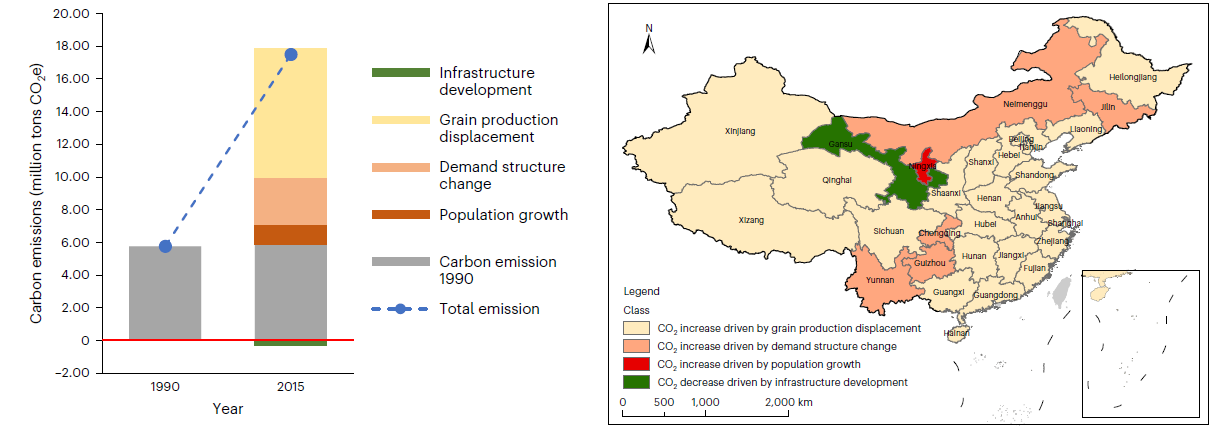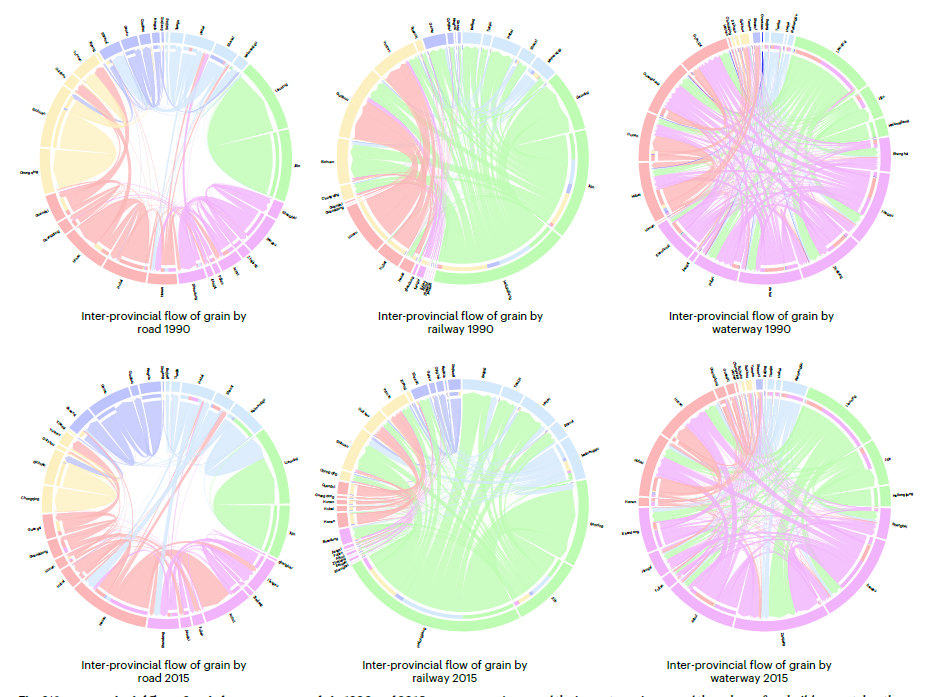南湖新闻网讯(通讯员 左成超)近日,我校公共管理学院“可持续土地系统Sustainable Land System”团队左成超副教授、柯新利教授与我校宏观农业研究院游良志教授以及来自英国利兹大学与华盛顿国际食物政策研究所的多位学者以“Cropland displacement contributed 60% of the increase in carbon emissions of grain transport in China over 1990–2015”为题在国际期刊Nature Food发表研究成果。研究发现,1990-2015年间,我国粮食运输过程中产生的碳排放从568万吨增加到1769万吨,增长两倍以上,其中耕地位移贡献的碳排放增量超过了60%。该研究受到了中国农业科学院唐华俊院士团队的关注,由余强毅副研究员、吴文斌研究员与唐华俊院士联合撰写的相关新闻评论文章“Increased food-miles and transport emissions”对本研究做出了全面的报道和积极的评价,同步刊发于Nature Food:https://www.nature.com/articles/s43016-023-00715-y。

各因素对粮食运输碳排放增量的贡献以及各省粮食运输碳排放增量的主导因素
耕地位移是我国典型的土地利用变化现象。随着城镇化的推进,城镇周边原有的耕地被城市扩张所侵占;为了维持粮食供应,远离城镇的生态用地与未利用地被开垦成耕地。从宏观角度来看,耕地的空间位置发生了显著偏移,我们将这种现象称为“耕地位移”,我国采取的严格耕地保护制度,在维持耕地总量方面取得了举世瞩目的成就,然而也不可避免的在一定程度上推动了耕地的位移。
在城镇化的过程中,耕地位移现象造成了耕地逐渐远离人口,在1990-2015年间我国耕地与人口的几何重心的距离增加了近70km。同时,城镇化也使越来越多的人口离开农村,迁移到城市。因此,从更远的农村运送更多的粮食到城市里,必然意味着更高的运输碳排放。该文运用交通地理学的相关方法,以空间交互模型(Spatial Interaction Model)为核心,搭建模型框架,在精细尺度上基于不同交通运输方式估算粮食从产地到消费地的空间流通量,并基于此估算粮食运输的碳排放量,以二氧化碳排放当量计量。最后,论文通过一系列情景假设模拟,揭示了耕地位移、人口增长、消费结构变化以及交通基础设施建设对粮食运输碳排放增量的贡献。

1990与2015年不同交通运输方式承担的省际粮食流通量
该论文丰富了食品供应链全生命周期的生态环境效应相关研究,为系统认识土地利用变化的生态环境效应提供了一个新的视角,为优化国土空间规划、改进耕地保护政策,实现国家现粮食安全与碳减排双重目标相协调提供了有力的支撑。
公共管理学院左成超副教授为论文第一作者,左成超副教授与柯新利教授为通讯作者。宏观农业研究院、华盛顿国际食物政策研究所游良志教授、利兹大学地理学院文成博士、Graham Clarke教授以及已毕业博士唐兰萍参与了本研究。该工作得到了校自主创新基金(2662020GGPY002),教育部哲学社会科学后期自主(重大)项目(21JHQ019)以及教育部哲学社会科学重大项目(20JZD015)的资助。
原文链接:
https://www.nature.com/articles/s43016-023-00708-x
英文摘要:
Rapid urbanization and population growth have increased the need for grain transportation in China, as more grain is being consumed and croplands have been moved away from cities. Increased grain transportation has, in turn, led to higher energy consumption and carbon emissions. Here we undertook a model-based approach to estimate the carbon emissions associated with grain transportation in the country between 1990 and 2015. We found that emissions more than tripled, from 5.68 million tons of CO2 emission equivalent in 1990 to 17.69 million tons in 2015. Grain production displacement contributed more than 60% of the increase in carbon emissions associated with grain transport over the study period, whereas changes in grain consumption and population growth contributed 31.7% and 16.6%, respectively. Infrastructure development, such as newly built highways and railways in western China, helped offset 0.54 million tons of CO2 emission equivalent from grain transport. These findings shed light on the life cycle environmental impact within food supply chains.
审核人:柯新利
